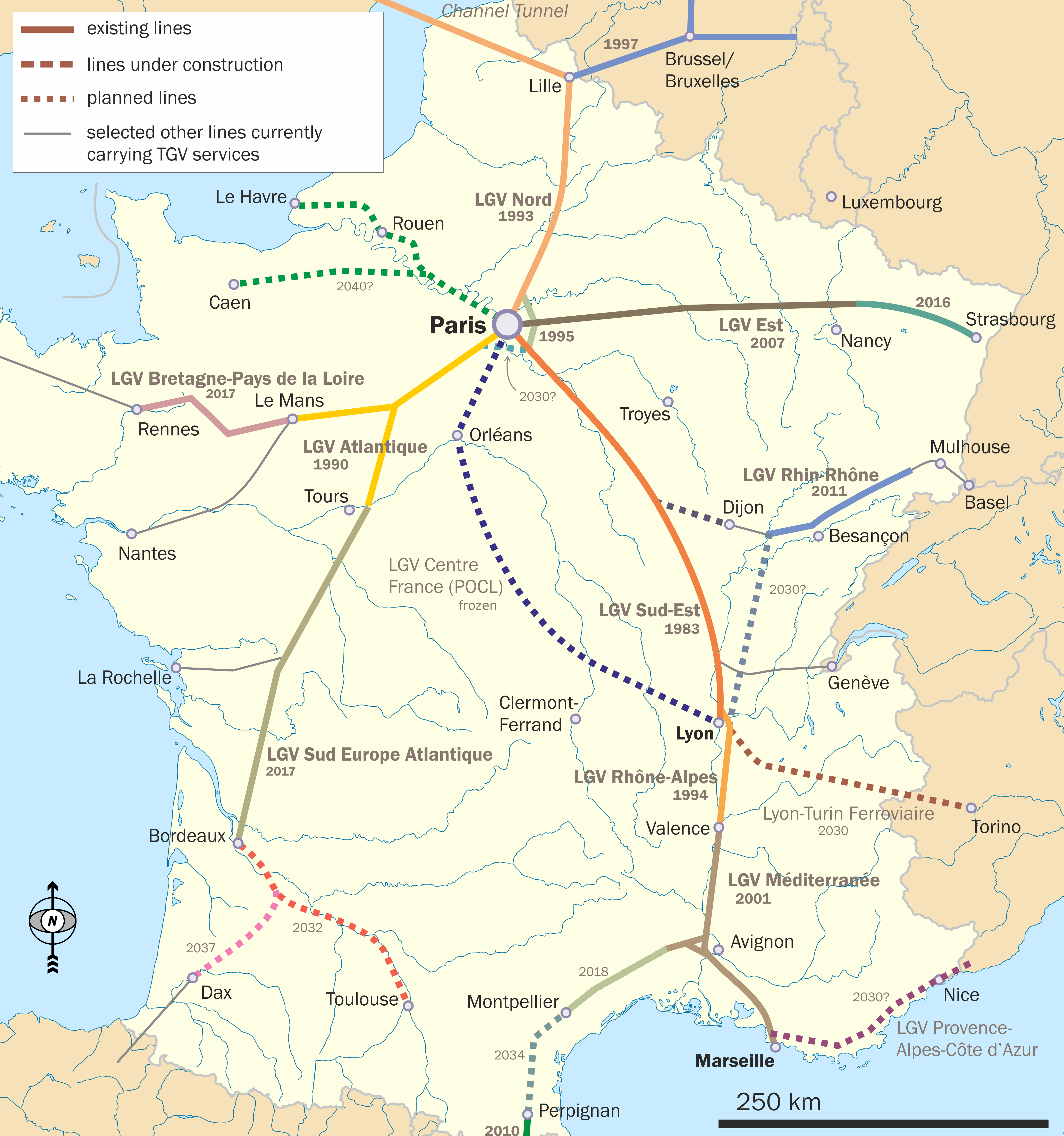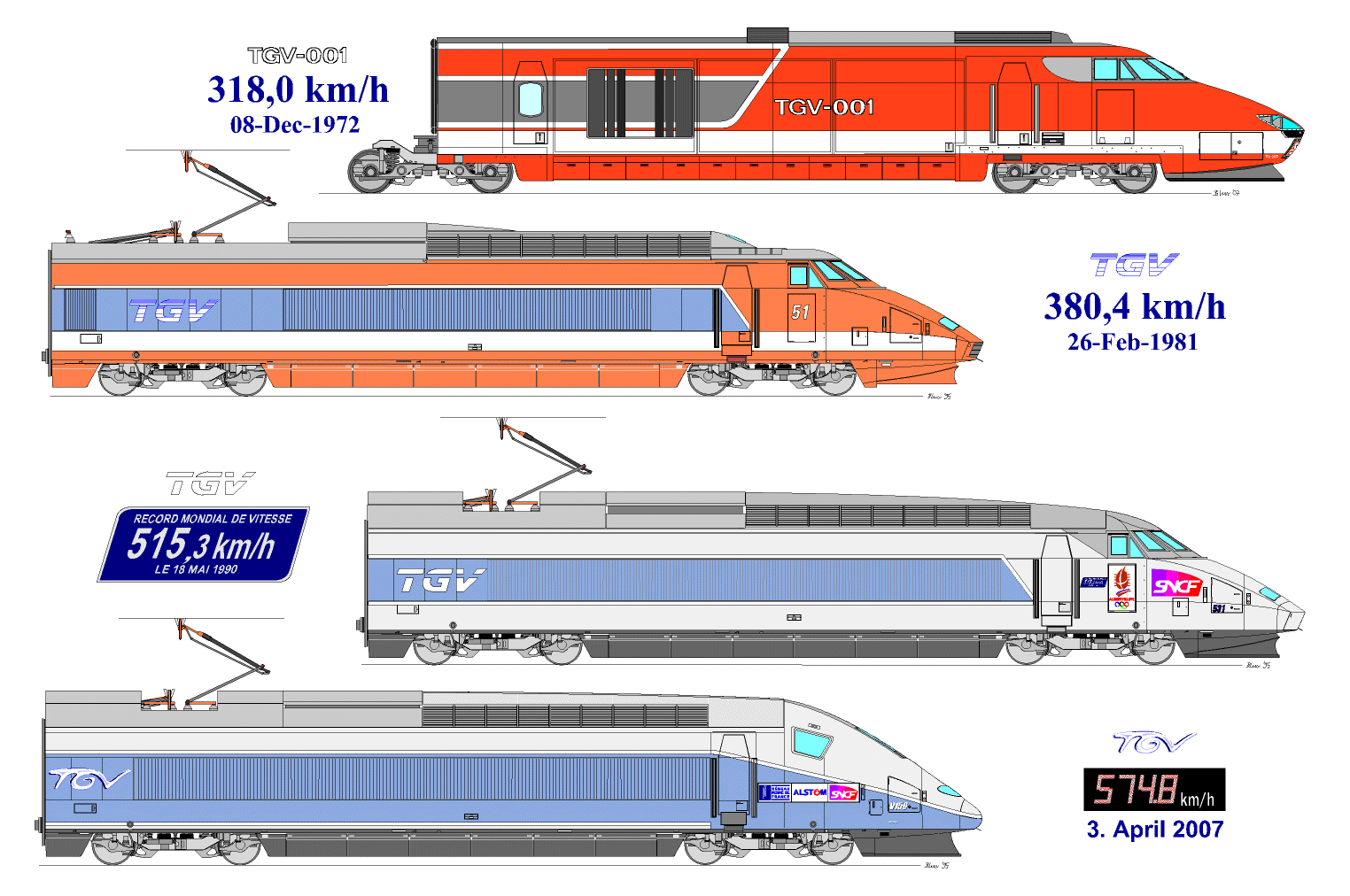|
LGV Est
The Ligne à Grande Vitesse Est européenne (East European High Speed Line), typically shortened to LGV Est, is a French high-speed rail line that connects Vaires-sur-Marne (near Paris) and Vendenheim (near Strasbourg). The line halved the travel time between Paris and Strasbourg and provides fast services between Paris and the principal cities of Eastern France as well as Luxembourg, Germany and Switzerland. The LGV Est is a segment of the Main Line for Europe project to connect Paris with Budapest with high-speed rail service. The line was built in two phases. Construction on the from Vaires-sur-Marne to Baudrecourt (near Metz and Nancy) began in 2004; the first phase entered into service in June 2007. Construction on the second phase from Baudrecourt to Vendenheim began in June 2010; the second phase opened to commercial service on 3 July 2016. Opening of the second phase was delayed after a train derailed near Eckwersheim during commissioning trials, resulting in 11 de ... [...More Info...] [...Related Items...] OR: [Wikipedia] [Google] [Baidu] |
Rambluzin-et-Benoite-Vaux
Rambluzin-et-Benoite-Vaux () is a commune in the Meuse department in Grand Est in north-eastern France. See also *Communes of the Meuse department *List of works by Henri Chapu Henri Chapu (1833–1891) was a French sculptor. Chapu was born in Le Mée-sur-Seine on 30 September 1833. He trained at the École Gratuite de Dessin as a tapestry maker. In 1849 his successes led him to the École des Beaux-Arts, Paris, where ... References Rambluzinetbenoitevaux {{Meuse-geo-stub ... [...More Info...] [...Related Items...] OR: [Wikipedia] [Google] [Baidu] |
Saverne Tunnel
The Saverne Tunnel (french: Tunnel de Saverne), also known as the Ernolsheim-lès-Saverne Tunnel (french: Tunnel d'Ernolsheim-lès-Saverne), is a twin-bore , high-speed rail tunnel in western Bas-Rhin, France. It carries the LGV Est line of France's TGV high-speed rail network through the narrowest part of the Vosges mountain range, beneath Mont Saint-Michel (Alsace), Mont Saint-Michel and adjacent to the Col de Saverne, Saverne Pass. The tunnel consists of two bores, containing one rail track each, that are connected by passageways every . The LGV Est crosses the Haspelbaechel viaduct near the western end of the tunnel. The tunnel was excavated by a tunnel boring machine between November 2011 and February 2013. Civil engineering work on the tunnel ended in April 2014 and it opened with the rest of the second phase of the LGV Est on 3 July 2016. The total cost of the tunnel was approximately €200 million. Background The Saverne Tunnel was constructed as part of the sec ... [...More Info...] [...Related Items...] OR: [Wikipedia] [Google] [Baidu] |
InterCityExpress
The Intercity Express (commonly known as ICE ()) is a system of high-speed trains predominantly running in Germany. It also serves some destinations in Austria, Denmark (ceased in 2017 but planned to resume in 2022), France, Belgium, Switzerland and the Netherlands, mostly as part of cross border services. It is the highest service category of rail and the flagship train of the German state railway, Deutsche Bahn. There are currently 315 trainsets in use. ICE trains are the highest category (Class A) trains in the fare system of the Deutsche Bahn. Their fares are not calculated on a fixed per-kilometre table as with other trains, but instead have fixed prices for station-to-station connections, levied on the grounds that the ICE trains have a higher level of comfort. Travelling at speeds up to , they are tailored for business travellers or long-distance commuters and are marketed by Deutsche Bahn as an alternative to flights. Apart from domestic use, the trains can also be seen ... [...More Info...] [...Related Items...] OR: [Wikipedia] [Google] [Baidu] |
France
France (), officially the French Republic ( ), is a country primarily located in Western Europe. It also comprises of Overseas France, overseas regions and territories in the Americas and the Atlantic Ocean, Atlantic, Pacific Ocean, Pacific and Indian Oceans. Its Metropolitan France, metropolitan area extends from the Rhine to the Atlantic Ocean and from the Mediterranean Sea to the English Channel and the North Sea; overseas territories include French Guiana in South America, Saint Pierre and Miquelon in the North Atlantic, the French West Indies, and many islands in Oceania and the Indian Ocean. Due to its several coastal territories, France has the largest exclusive economic zone in the world. France borders Belgium, Luxembourg, Germany, Switzerland, Monaco, Italy, Andorra, and Spain in continental Europe, as well as the Kingdom of the Netherlands, Netherlands, Suriname, and Brazil in the Americas via its overseas territories in French Guiana and Saint Martin (island), ... [...More Info...] [...Related Items...] OR: [Wikipedia] [Google] [Baidu] |
Wuhan–Guangzhou High-Speed Railway
The Wuhan–Guangzhou high-speed railway, also called the Wuguang high-speed railway and short for Beijing–Guangzhou–Shenzhen–Hong Kong high-speed railway, Wuhan–Guangzhou section, is a high-speed rail line, operated by China Railway High-speed (CRH), connecting Wuhan and Guangzhou, the provincial capitals of Hubei and Guangdong, respectively. It was the world's fastest train service, initially using coupled CRH2C and CRH3C trains which averages in non-stop commercial service. The line is part of the 2230-km long Beijing–Guangzhou–Shenzhen–Hong Kong high-speed railway. Since the railway line opened ten years ago, it has transported 500 million passengers and provided over 500000 train services. Rolling stock When the line opened, the trains had a maximum in-service speed of according to Chinese sources. Each train consists of two eight-car electric multiple units coupled together to make a 16-car train. The passenger capacity of the train is about 1114 (CRH3C� ... [...More Info...] [...Related Items...] OR: [Wikipedia] [Google] [Baidu] |
Railway Gazette International
''Railway Gazette International'' is a monthly business magazine and news website covering the railway, metro, light rail and tram industries worldwide. Available by annual subscription, the magazine is read in over 140 countries by transport professionals and decision makers, railway managers, engineers, consultants and suppliers to the rail industry. A mix of technical, commercial and geographical feature articles, plus the regular monthly news pages, cover developments in all aspects of the rail industry, including infrastructure, operations, rolling stock and signalling. History ''Railway Gazette International'' traces its history to May 1835 as ''The Railway Magazine'', when it was founded by Effingham Wilson. The ''Railway Gazette'' title dates from July 1905, created to cover railway commercial and financial affairs. In April 1914 it merged with ''The Railway Times'', which incorporated '' Herapath's Railway Journal'', and in February 1935 it absorbed the ''Railway Engine ... [...More Info...] [...Related Items...] OR: [Wikipedia] [Google] [Baidu] |
International Railway Journal
The ''International Railway Journal'' (IRJ) is a monthly international trade magazine published by Simmons-Boardman Publishing in Falmouth, England. History Founded by Robert Lewis and ''Railway Age'' editor Luther Miller as the world's first globally distributed magazine for the railway industry, the first edition of IRJ was published as a pilot in October 1960. Monthly production commenced in January 1961. Content The magazine covers a range of rail-related content, covering sectors including passenger, freight, high-speed, metro and light rail. Regular subject matters include financial news, fleet orders, infrastructure, new technologies and government policy. Circulation and Distribution IRJ publishes regular content on its website, and also publishes a monthly print edition, distributed through controlled circulation. IRJ's print edition had a circulation of 10,234 copies in 2020, according to the Audit Bureau of Circulations (UK). [...More Info...] [...Related Items...] OR: [Wikipedia] [Google] [Baidu] |
Land Speed Record For Rail Vehicles
The world record for a conventional wheeled passenger train is held by France's TGV (''Train à Grande Vitesse''), set in 2007 when it reached on a section of track. Japan's experimental maglev train L0 Series achieved on a 42.8 km magnetic levitation track in 2015. World speed records Legend: ; Arr (Arrangement) : Disposition and number of elements forming the train. :; Loc:One locomotive pulling one or more cars) :; Multi :Multi Motorized Elements :; Single :Single rail vehicle ; Power: DC, DC 3rd rail, AC, Single phase, Triphase, Diesel-elec., Gas, Steam, Diesel-hydraulic, Propeller, Rocket, Jet. ; State: "Proto." (Prototype), "Unmod." (Unmodified from vehicles in service), "unknown" (Unknown), "Tuned" All passenger trains The following is a partial list of absolute world speed records for all trains designed to carry passengers, regardless of gauge, propulsion or type of rail, , - , , , , 1938-20-07 , , Bologna-Milano line between Pontenure and Piacenza ... [...More Info...] [...Related Items...] OR: [Wikipedia] [Google] [Baidu] |
Eric Pieczak
The TGV (''Train à Grande Vitesse'', French for "High-Speed Train") holds a series of land speed records for rail vehicles achieved by SNCF, the French national railway, and its industrial partners. The high-speed trials are intended to expand the limits of high-speed rail technology, increasing speed and comfort without compromising safety. The current world speed record for a commercial train on steel wheels is held by the French TGV at 574.8 km/h (357.2 mph), achieved on 3 April 2007 on the new LGV Est. TGV 001 The TGV 001 was an experimental gas turbine-electric locomotive-powered trainset built by Alstom to break speed records between 250–300 kilometres per hour. It was the first TGV prototype and was commissioned in 1969, to begin testing in 1972. It achieved a top speed of on 8 December 1972. Record of 1981 Operation TGV 100 Operation TGV 100, referring to a target speed of 100 metres per second (360 km/h, 224 mph), took place on 26 Fe ... [...More Info...] [...Related Items...] OR: [Wikipedia] [Google] [Baidu] |
Project V150 (High Speed Train) - France
Operation V150, where 150 refers to a target speed in metres per second, was a series of high-speed trials carried out on the LGV Est. The V150 was a specially configured TGV high-speed train (weighing only ) notable for breaking the world railway speed record on 3 April 2007. The train was built in France and reached a speed of on an unopened section of the LGV Est between Strasbourg and Paris, in France topping the previous record of 515.3 kilometres per hour (320.2 mph) set in 1990. Record of 2007 Operation V150 trials were carried out on the LGV Est prior to its June 2007 opening. The trials were conducted jointly by SNCF, TGV builder Alstom, and LGV Est owner Réseau Ferré de France between 15 January 2007 and 15 April 2007. Following a series of increasingly high-speed runs, the official speed record attempt took place on 3 April 2007. The top speed of , ) was reached at kilometre point 191 near the village of Le Chemin, between the Meuse and Champagne-Ardenne ... [...More Info...] [...Related Items...] OR: [Wikipedia] [Google] [Baidu] |
Eckwersheim Derailment
On 14 November 2015, a TGV train derailed in Eckwersheim, Alsace, France, while performing commissioning trials on the second phase of the LGV Est high-speed rail line, which was scheduled to open for commercial service five months later. The derailment resulted in 11 deaths among those aboard, while the 42 others aboard the train were injured. It was the first fatal derailment in the history of the TGV and the third derailment since the TGV entered commercial service in 1981. The test train was traveling eastbound on the southern track when it entered a curve at — over its assigned speed—causing the rear bogie of the lead power car to derail to the left (outside of curve) due to centrifugal forces. The lead power car separated from the rest of the train, and the rear of the lead power car struck the concrete parapet on the abutment to a bridge over the Marne–Rhine Canal. The power car slid along the left parapet of the bridge and overturned, sliding down the embankment an ... [...More Info...] [...Related Items...] OR: [Wikipedia] [Google] [Baidu] |



